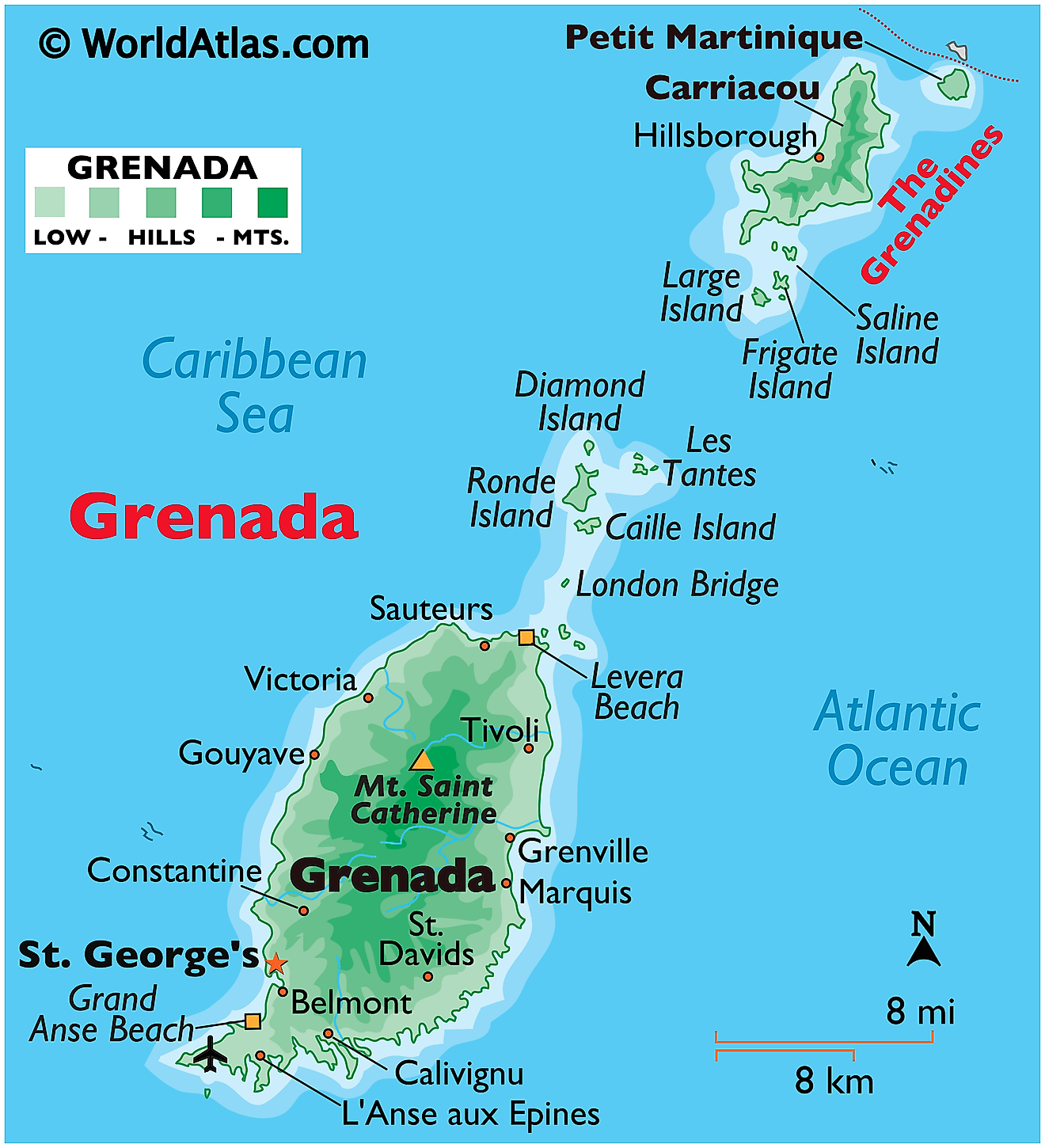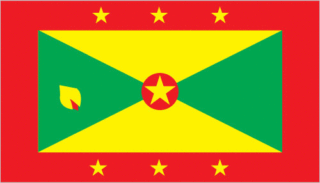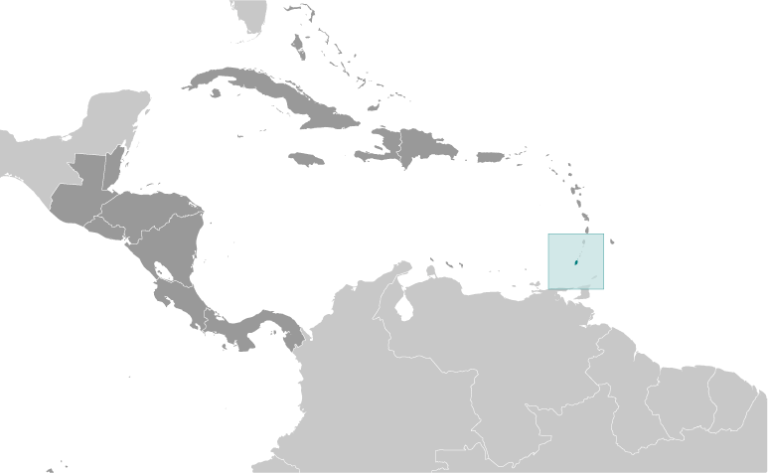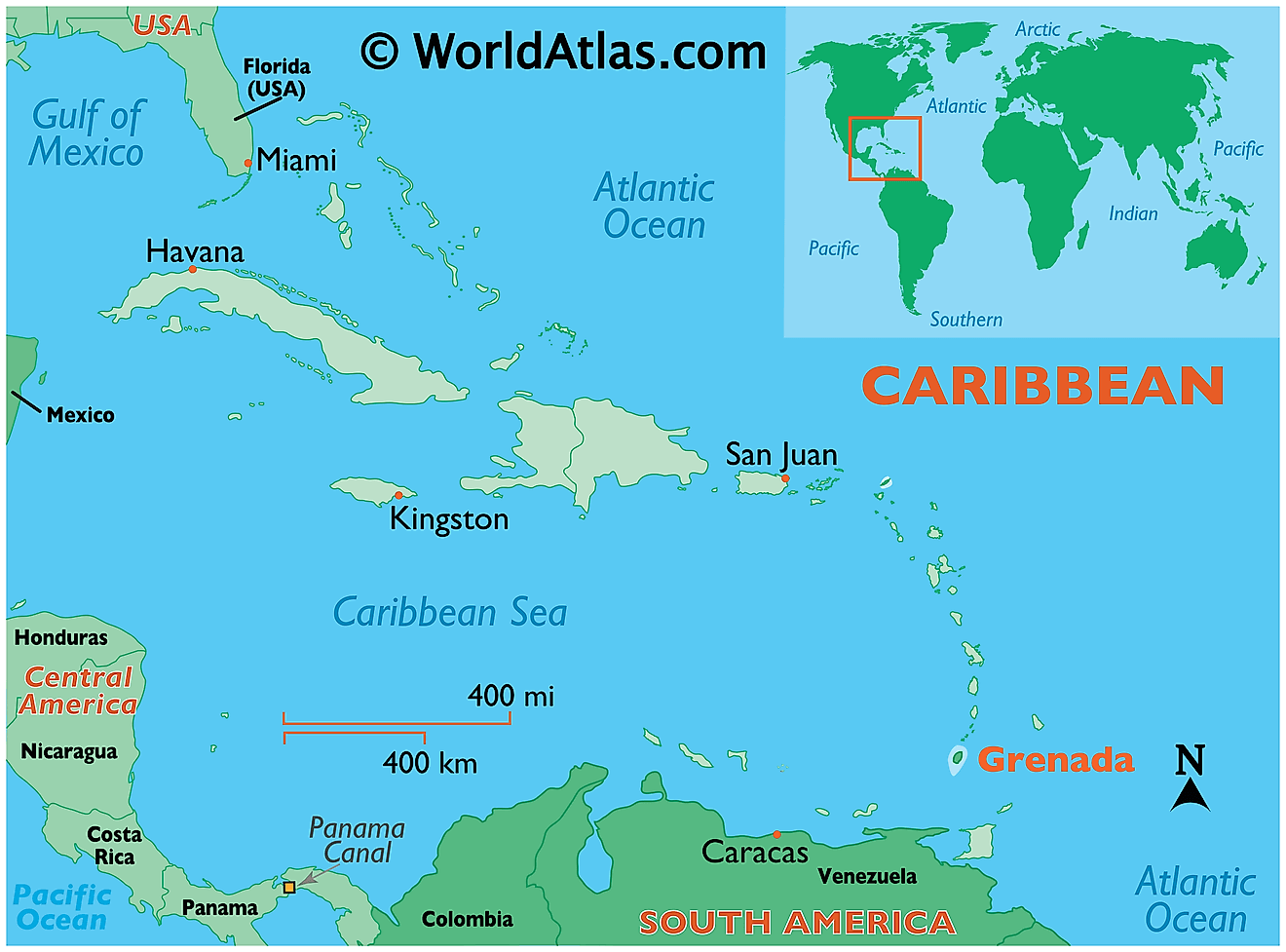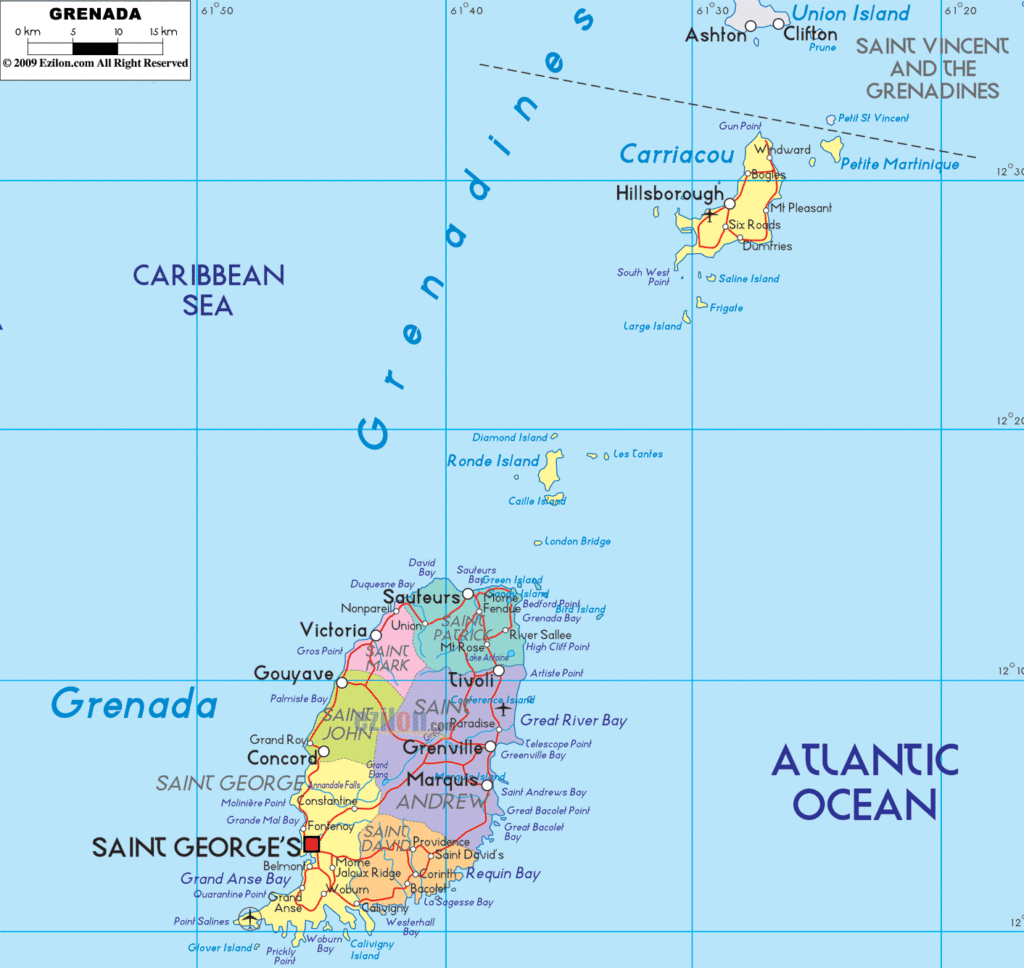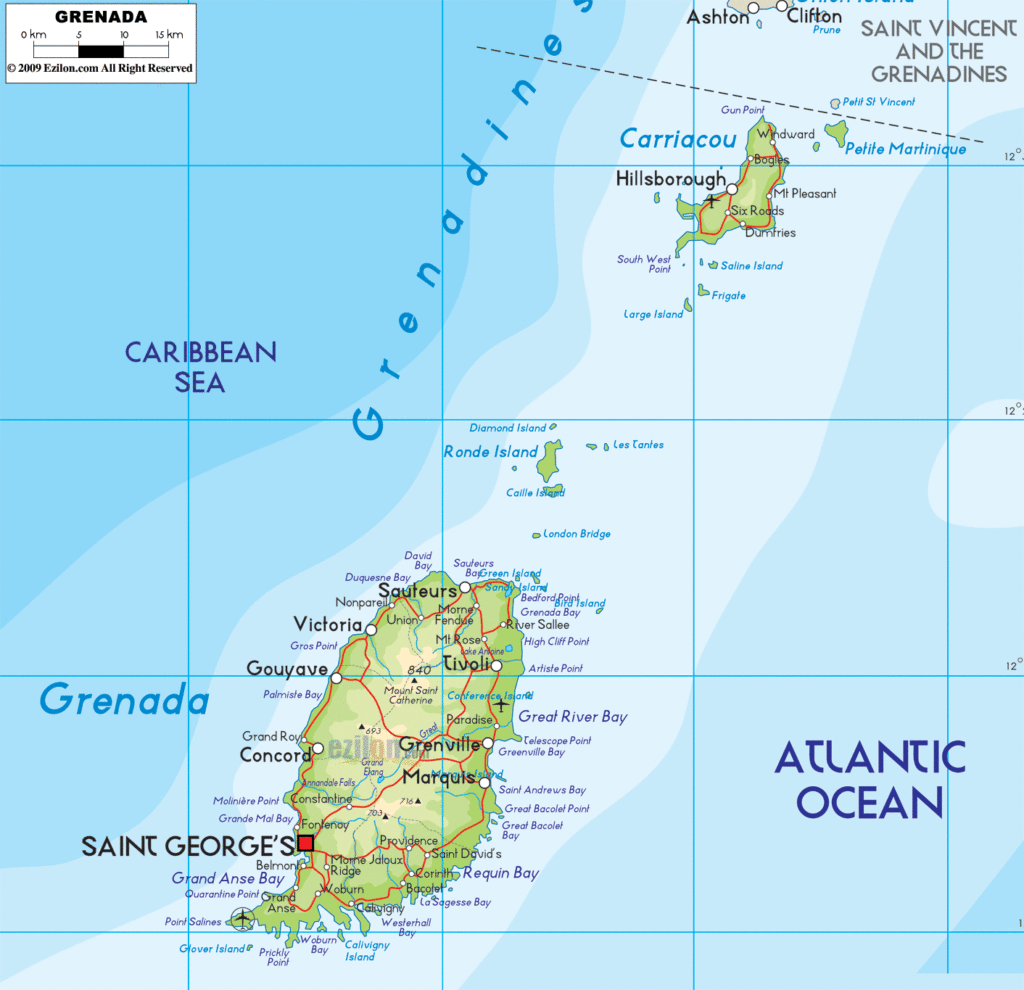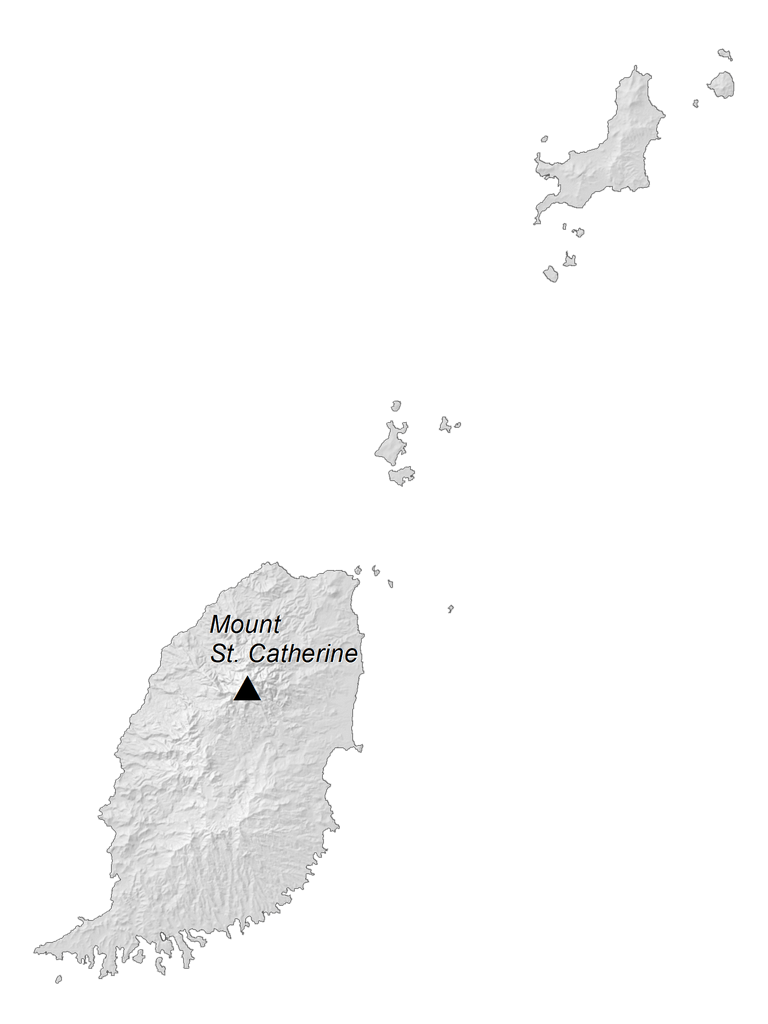Covering a total area of only 348.5 sq. km (134.6 sq mi), the country of Grenada consists of the main island of Grenada, the larger islands of Carriacou and Petit Martinique, and some 600 small islets, mostly uninhabited. The islands of the country of Grenada are all volcanic in origin and vary in elevation from 300m (984ft), to over 600m (1,968 ft).
As observed on the map, the island of Grenada itself is more mountainous than the others and are covered by dense forest. Its land rises from a narrow, coastal plain into areas of dormant volcanic ridges and valleys. Mount St. Catherine is the highest point rising to 840 m (2,760 ft). The island is drained by many small rivers flowing to the sea, all cutting deeply into the slopes.
A few of the mountains contain crater basins, and one includes a large crater lake named Grand Etang. The lake is over 1700ft above sea level, and is surrounded with some of the island’s most beautiful rainforest. Waterfalls are scattered across the upper-reaches of Grenada, as well as a few boiling springs; the River Sallee boiling springs is the most significant.
Grenada is a beautiful Caribbean island full of natural wonders. From its soaring mountains to its lush rainforests, the island is a sight to behold. To help you explore it, this map of Grenada shows islands, populated places, and highways. It also features a satellite and elevation map so you can get a better view of the terrain.
Online Interactive Political Map
Click on ![]() to view map in "full screen" mode.
to view map in "full screen" mode.
Grenada is divided into 6 parishes and 1 dependency. In alphabetical order, the parishes are: Saint Andrew, Saint David, Saint George, Saint John, Saint Mark and Saint Patrick. Carriacou and Petite Martinique have the status of a dependency.
Covering a total area of only 344 sq. km, Grenada is one of the smallest independent nations in the Western hemisphere; and is famously known as the ‘Island of Spice’. Located on a horseshoe-shaped harbour is St. George’s – the capital and the largest city of Grenada. It is the administrative center of the country and is a popular tourist destination in the Caribbean.
Location Maps
Where is Grenada?
Grenada is an island country located in the Caribbean Sea near St. Vincent and the Grenadines, Venezuela, as well as Trinidad and Tobago. Covering an area of 348 square kilometers, it is slightly smaller than Saint Vincent and the Grenadines. The country has an estimated population of 112,500 people, of which 30% reside in the capital city of Saint George’s. It is nicknamed the “Island of Spice” due to its production of nutmeg and mace crops.
High Definition Political Map of Grenada
History
Pre-Columbian history
Grenada was first populated by peoples from South America, possibly during the Caribbean Archaic Age, although definitive evidence is lacking. The earliest potential human presence comes from proxy evidence of lake cores, beginning ~3600 BC. Less ephemeral, permanent villages began around ~AD 100–200. The population peaked between AD 750–1250, with major changes in population afterwards, potentially the result of regional droughts and/or the “Carib Invasion”, although the latter rests on highly circumstantial evidence.
European arrival
In 1498, Christopher Columbus was the first European to report sighting Grenada during his third voyage, naming it ‘La Concepción’, but Amerigo Vespucci may have renamed it ‘Mayo’ in 1499. Although it was deemed the property of the King of Spain, there are no records to suggest the Spanish attempted to settle, although various Europeans are known to have passed and both fought and/or traded with the indigenous peoples there. The first known settlement attempt was a failed venture by the English in 1609, but they were massacred and driven away by the native “Carib” peoples.
French colony (1649–1763)
In 1649, a French expedition of 203 men from Martinique, led by Jacques Dyel du Parquet, founded a permanent settlement on Grenada. They signed a peace treaty with the Carib chief Kairouane, but within months conflict broke out between the two communities. This lasted until 1654 when the island was completely subjugated by the French. The indigenous peoples who survived either left for neighbouring islands or retreated to more remote parts of Grenada, where they ultimately disappeared during the 1700s. Warfare continued during the 1600s between the French on Grenada and the Caribs of present-day Dominica and St. Vincent and the Grenadines.
Chocolate was brought to Grenada in 1714 with the introduction of cocoa beans.
The French named their new colony La Grenade, and the economy was initially based on sugar cane and indigo, worked by African slaves. The French established a capital known as Fort Royal (later St. George’s). To shelter from hurricanes, the French navy would often take refuge in the capital’s natural harbour, as no nearby French islands had a natural harbour to compare with that of Fort Royal. The British captured Grenada during the Seven Years’ War in 1762.
British colonial period
Grenada was formally ceded to Britain by the Treaty of Paris in 1763. The French re-captured the island during the American Revolutionary War, after Comte d’Estaing won the bloody land and naval Battle of Grenada in July 1779. However, the island was restored to Britain with the Treaty of Versailles in 1783. A decade later, dissatisfaction with British rule led to a pro-French revolt in 1795–96 led by Julien Fédon, which was successfully defeated by the British.
As Grenada’s economy grew, more and more African slaves were forcibly transported to the island. Britain eventually outlawed the slave trade within the British Empire in 1807, and slavery was completely outlawed in 1833, leading to the emancipation of all enslaved by 1838. In an effort to ameliorate the subsequent labour shortage, migrants from India were brought to Grenada in 1857.
Nutmeg was introduced to Grenada in 1843, when a merchant ship called in on its way to England from the East Indies. The ship had a small quantity of nutmeg trees on board which they left in Grenada, and this was the beginning of Grenada’s nutmeg industry that now supplies nearly 40% of the world’s annual crop.
In 1877, Grenada was made a Crown colony. Theophilus A. Marryshow founded the Representative Government Association (RGA) in 1917 to agitate for a new and participative constitutional dispensation for the Grenadian people. Partly as a result of Marryshow’s lobbying, the Wood Commission of 1921–22 concluded that Grenada was ready for constitutional reform in the form of a modified Crown colony government. This modification granted Grenadians the right to elect five of the 15 members of the Legislative Council, on a restricted property franchise enabling the wealthiest 4% of adult Grenadians to vote. Marryshow was named a Commander of the Order of the British Empire (CBE) in 1943.
In 1950, Eric Gairy founded the Grenada United Labour Party (GULP), initially as a trade union, which led the 1951 general strike for better working conditions. This sparked great unrest, and so many buildings were set ablaze that the disturbances became known as the “red sky” days. The British authorities decided to call in military reinforcements to help regain control of the situation. On 10 October 1951, Grenada held its first general elections on the basis of universal adult suffrage, with Gairy’s party winning six of the eight seats contested.
From 1958 to 1962, Grenada was part of the Federation of the West Indies. After the federation’s collapse, Grenada was granted full autonomy over its internal affairs as an Associated State on 3 March 1967. Herbert Blaize of the Grenada National Party (GNP) was the first Premier of the Associated State of Grenada from March to August 1967. Eric Gairy served as Premier from August 1967 until February 1974.
Post-independence era
Independence was granted on 7 February 1974 under the leadership of Eric Gairy, who became the first prime minister of Grenada. Grenada opted to remain within the Commonwealth, retaining Queen Elizabeth as Monarch, represented locally by a governor-general. Civil conflict gradually broke out between Eric Gairy’s government and some opposition parties, including the Marxist New Jewel Movement (NJM). Gairy and the GULP won the 1976 Grenadian general election, albeit with a reduced majority; however, the opposition deemed the results invalid due to fraud and the violent intimidation performed by the so-called ‘Mongoose Gang’, a private militia loyal to Gairy.
On 13 March 1979, whilst Gairy was out of the country, the NJM launched a bloodless coup which removed Gairy, suspended the constitution, and established a People’s Revolutionary Government (PRG), headed by Maurice Bishop who declared himself prime minister. His Marxist–Leninist government established close ties with Cuba, Nicaragua, and other communist bloc countries. All political parties except for the New Jewel Movement were banned and no elections were held during the four years of PRG rule.
Invasion by the United States (1983)
Some years later, a dispute developed between Bishop and certain high-ranking members of the NJM. Though Bishop cooperated with Cuba and the USSR on various trade and foreign policy issues, he sought to maintain a “non-aligned” status. Hardline Marxist party members, including communist Deputy Prime Minister Bernard Coard, deemed Bishop insufficiently revolutionary and demanded that he either step down or enter into a power-sharing arrangement.
On 16 October 1983, Bernard Coard and his wife, Phyllis, backed by the Grenadian Army, led a coup against the government of Maurice Bishop and placed Bishop under house arrest. These actions led to street demonstrations in various parts of the island because Bishop had widespread support from the population. Because Bishop was a widely popular leader, he was freed by impassioned supporters who marched en masse to his guarded residence from a rally in the capital’s central square. Bishop then led the crowd to the island’s military headquarters to reassert his power. Grenadian soldiers were dispatched in armoured vehicles by the Coard faction to retake the fort. A confrontation between soldiers and civilians at the fort ended in gunfire and panic. Three soldiers and at least eight civilians died in the tumult that also injured 100 others, a school-sponsored study later found. When the initial shooting ended with Bishop’s surrender, he and a group of seven of his closest supporters were taken prisoner and executed by firing squad. Besides Bishop, the group included three of his cabinet ministers, a trade union leader and three service-industry workers.
After the execution of Bishop, the People’s Revolutionary Army (PRA) formed a military Marxist government with General Hudson Austin as chairman. The army declared a four-day total curfew, during which anyone leaving their home without approval would be shot on sight.
US President Ronald Reagan stated that particularly worrying was the presence of Cuban construction workers and military personnel building a 10,000-foot (3,000 m) airstrip on Grenada. Bishop had stated the purpose of the airstrip was to allow commercial jets to land, but some US military analysts argued that the only reason for constructing such a long and reinforced runway was so that it could be used by heavy military transport planes. The contractors, American and European companies, and the EEC, which provided partial funding, all claimed the airstrip did not have military capabilities. Reagan claimed that Cuba, under the direction of the Soviet Union, would use Grenada as a refuelling stop for Cuban and Soviet aeroplanes loaded with weapons destined for Central American communist insurgents.
The Organization of Eastern Caribbean States (OECS), Barbados, and Jamaica all appealed to the United States for assistance. On 25 October 1983, combined forces from the United States and from the Regional Security System (RSS) based in Barbados invaded Grenada in an operation codenamed Operation Urgent Fury. The US stated this was done at the behest of Barbados, Dominica and Governor-General Paul Scoon. Scoon had requested the invasion through secret diplomatic channels, but it was not made public for his safety. Progress was rapid, and within four days the Americans had removed the military government of Hudson Austin.
The invasion was criticised by the governments of Britain, Trinidad and Tobago, and Canada. The United Nations General Assembly condemned it as “a flagrant violation of international law” by a vote of 108 to 9, with 27 abstentions. The United Nations Security Council considered a similar resolution, which was supported by 11 nations. However, the United States vetoed the motion.
After the invasion, the pre-revolutionary Grenadian constitution came into operation once again. Eighteen members of the PRG/PRA were arrested on charges related to the murder of Maurice Bishop and seven others. The 18 included the top political leadership of Grenada at the time of the execution, along with the entire military chain of command directly responsible for the operation that led to the executions. Fourteen were sentenced to death, one was found not guilty, and three were sentenced to 45 years in prison. The death sentences were eventually commuted to terms of imprisonment. Those in prison have become known as ‘the Grenada 17’.
Since 1983
When US troops withdrew from Grenada in December 1983, Governor-General Scoon appointed an interim advisory council chaired by Nicholas Brathwaite to organise new elections. The first democratic elections since 1976 were held in December 1984, and were won by the New National Party under Herbert Blaize, who served as prime minister until his death in December 1989.
Ben Jones briefly succeeded Blaize as prime minister and served until the March 1990 election. This election was won by the National Democratic Congress under Nicholas Brathwaite, who served as prime minister until he resigned in February 1995. He was succeeded by George Brizan for a brief period until the June 1995 election which was won by the New National Party under Keith Mitchell, who went on to win the 1999 and 2003 elections, serving for a record 13 years until 2008. Mitchell re-established relations with Cuba and also reformed the country’s banking system, which had come under criticism over potential money laundering concerns.
In 2000–02, much of the controversy of the late 1970s and early 1980s was once again brought into the public consciousness with the opening of the truth and reconciliation commission. The commission was chaired by a Roman Catholic priest, Father Mark Haynes, and was tasked with uncovering injustices arising from the PRA, Bishop’s regime, and before. It held a number of hearings around the country. Brother Robert Fanovich, head of Presentation Brothers’ College (PBC) in St. George’s, tasked some of his senior students with conducting a research project into the era and specifically into the fact that Maurice Bishop’s body was never discovered. Paterson also uncovered that there was still a lot of resentment in Grenadian society resulting from the era and a feeling that there were many injustices still unaddressed.
On 7 September 2004, after being hurricane-free for 49 years, the island was directly hit by Hurricane Ivan. Ivan struck as a Category 3 hurricane, resulting in 39 deaths and damage or destruction to 90% of the island’s homes. On 14 July 2005, Hurricane Emily, a Category 1 hurricane at the time, struck the northern part of the island with 80-knot (150 km/h; 92 mph) winds, killing one person and causing an estimated US$110 million (EC$297 million) worth of damage. Agriculture, and in particular the nutmeg industry, suffered serious losses, but that event caused changes in crop management and it is hoped that as new nutmeg trees mature, the industry will gradually rebuild.
Mitchell was defeated in the 2008 election by the NDC under Tillman Thomas, however he won the 2013 Grenadian general election by a landslide and the NNP returned to power, winning again by another landslide in 2018. In March 2020, Grenada confirmed its first case of COVID-19 and, as of 17 March 2022, 13,921 cases and 217 deaths had been recorded.
On 23 June 2022, the NDC won the general election under Dickon Mitchell, who became prime minister the following day.
Physical Map of Grenada
